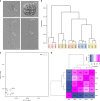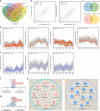Cell lineage-specific transcriptome analysis for interpreting cell fate specification of proembryos
- PMID: 32170064
- PMCID: PMC7070050
- DOI: 10.1038/s41467-020-15189-w
Cell lineage-specific transcriptome analysis for interpreting cell fate specification of proembryos
Abstract
In Arabidopsis, a zygote undergoes asymmetrical cell division that establishes the first two distinct cell types of early proembryos, apical and basal cells. However, the genome-wide transcriptional activities that guide divergence of apical and basal cell development remain unknown. Here, we present a comprehensive transcriptome analysis of apical and basal cell lineages, uncovering distinct molecular pathways during cell lineage specification. Selective deletion of inherited transcripts and specific de novo transcription contribute to the establishment of cell lineage-specific pathways for cell fate specification. Embryo-related pathways have been specifically activated in apical cell lineage since 1-cell embryo stage, but quick transcriptome remodeling toward suspensor-specific pathways are found in basal cell lineage. Furthermore, long noncoding RNAs and alternative splicing isoforms may be involved in cell lineage specification. This work also provides a valuable lineage-specific transcriptome resource to elucidate the molecular pathways for divergence of apical and basal cell lineages at genome-wide scale.
Conflict of interest statement
The authors declare no competing interests.
Figures







Similar articles
-
Isolation of living apical and basal cell lineages of early proembryos for transcriptome analysis.Plant Reprod. 2019 Mar;32(1):105-111. doi: 10.1007/s00497-018-00353-6. Epub 2018 Dec 13. Plant Reprod. 2019. PMID: 30547251
-
The autonomous cell fate specification of basal cell lineage: the initial round of cell fate specification occurs at the two-celled proembryo stage.Plant J. 2017 Sep;91(6):1051-1063. doi: 10.1111/tpj.13629. Epub 2017 Aug 11. Plant J. 2017. PMID: 28671744
-
NtDRP is necessary for accurate zygotic division orientation and differentiation of basal cell lineage toward suspensor formation.New Phytol. 2016 Nov;212(3):598-612. doi: 10.1111/nph.14060. Epub 2016 Jun 27. New Phytol. 2016. PMID: 27348863
-
Early embryogenesis in flowering plants: setting up the basic body pattern.Annu Rev Plant Biol. 2012;63:483-506. doi: 10.1146/annurev-arplant-042811-105507. Epub 2012 Jan 3. Annu Rev Plant Biol. 2012. PMID: 22224452 Review.
-
Transcriptional switches direct plant organ formation and patterning.Curr Top Dev Biol. 2012;98:229-57. doi: 10.1016/B978-0-12-386499-4.00009-4. Curr Top Dev Biol. 2012. PMID: 22305165 Free PMC article. Review.
Cited by
-
The Arabidopsis embryo as a quantifiable model for studying pattern formation.Quant Plant Biol. 2021 Apr 12;2:e3. doi: 10.1017/qpb.2021.3. eCollection 2021. Quant Plant Biol. 2021. PMID: 37077211 Free PMC article. Review.
-
Gene expression variation in Arabidopsis embryos at single-nucleus resolution.Development. 2021 Jul 1;148(13):dev199589. doi: 10.1242/dev.199589. Epub 2021 Jul 6. Development. 2021. PMID: 34142712 Free PMC article.
-
PLETHORA transcription factors promote early embryo development through induction of meristematic potential.Development. 2024 Jun 15;151(12):dev202527. doi: 10.1242/dev.202527. Epub 2024 Jun 17. Development. 2024. PMID: 38884589 Free PMC article.
-
Transcriptional control of Arabidopsis seed development.Planta. 2022 Mar 23;255(4):90. doi: 10.1007/s00425-022-03870-x. Planta. 2022. PMID: 35318532 Free PMC article. Review.
-
Whole-mount RNA in situ hybridization technique in Torenia ovules.Plant Reprod. 2023 Jun;36(2):139-146. doi: 10.1007/s00497-022-00455-2. Epub 2022 Dec 21. Plant Reprod. 2023. PMID: 36543964
References
Publication types
MeSH terms
Substances
LinkOut - more resources
Full Text Sources
Molecular Biology Databases

